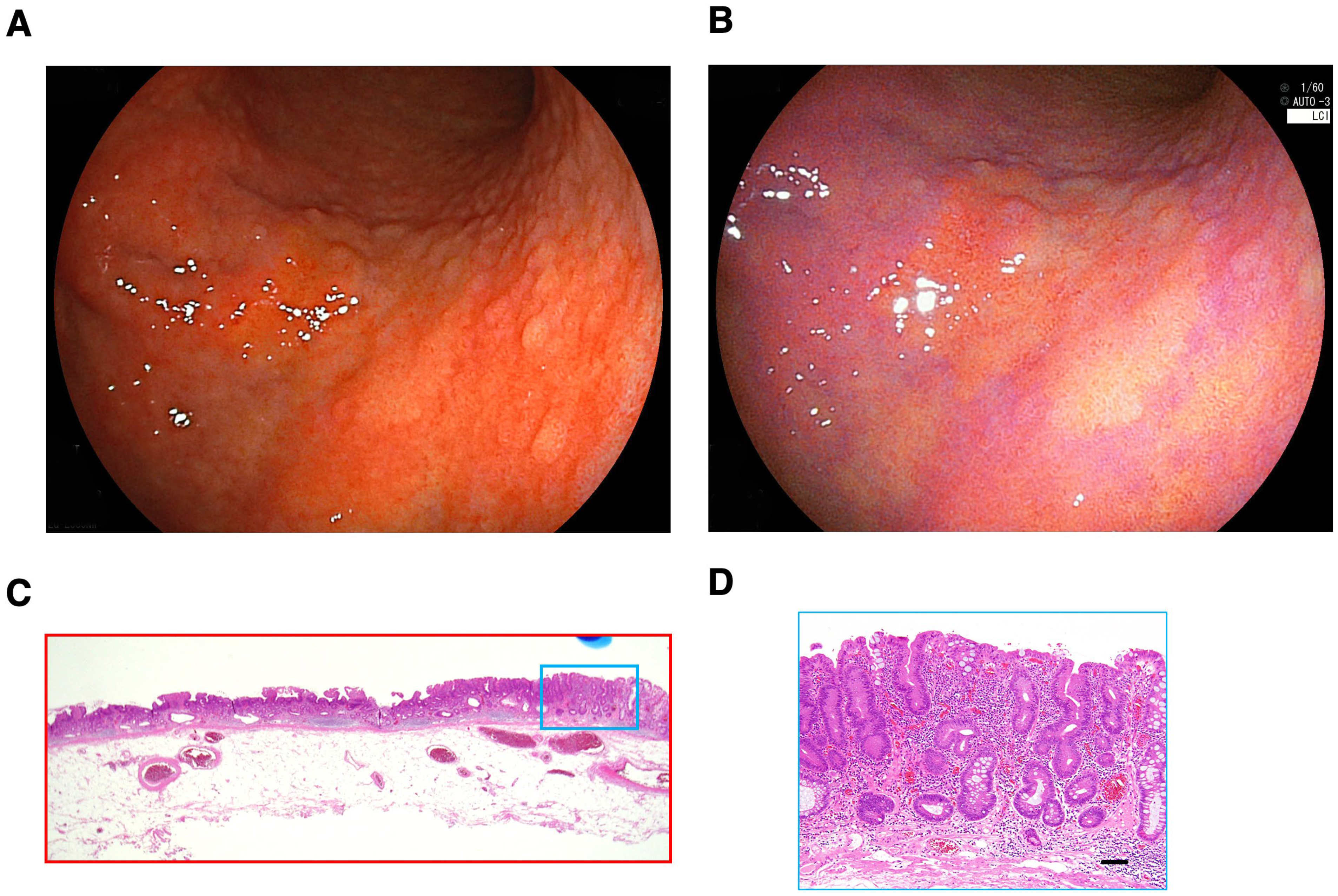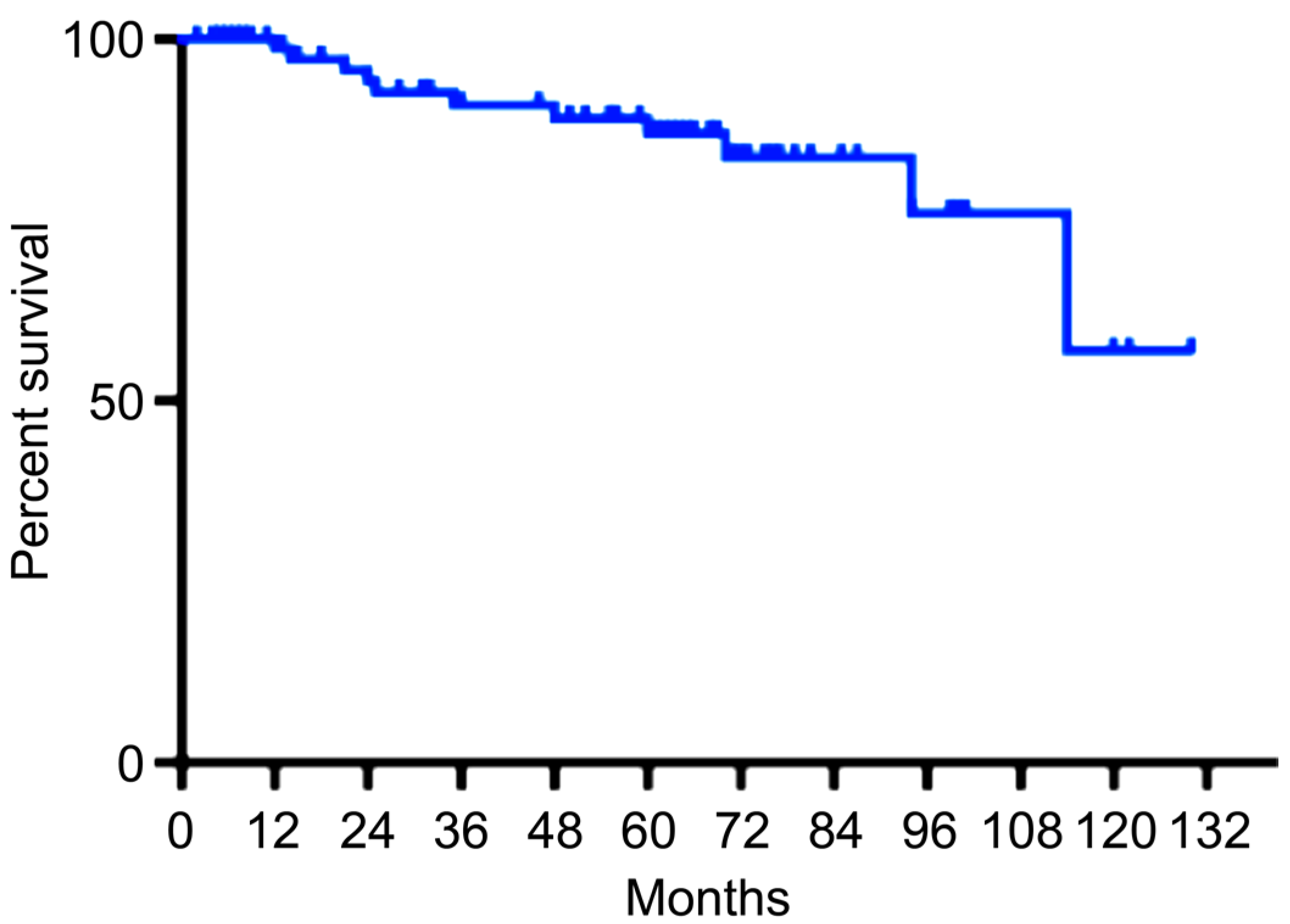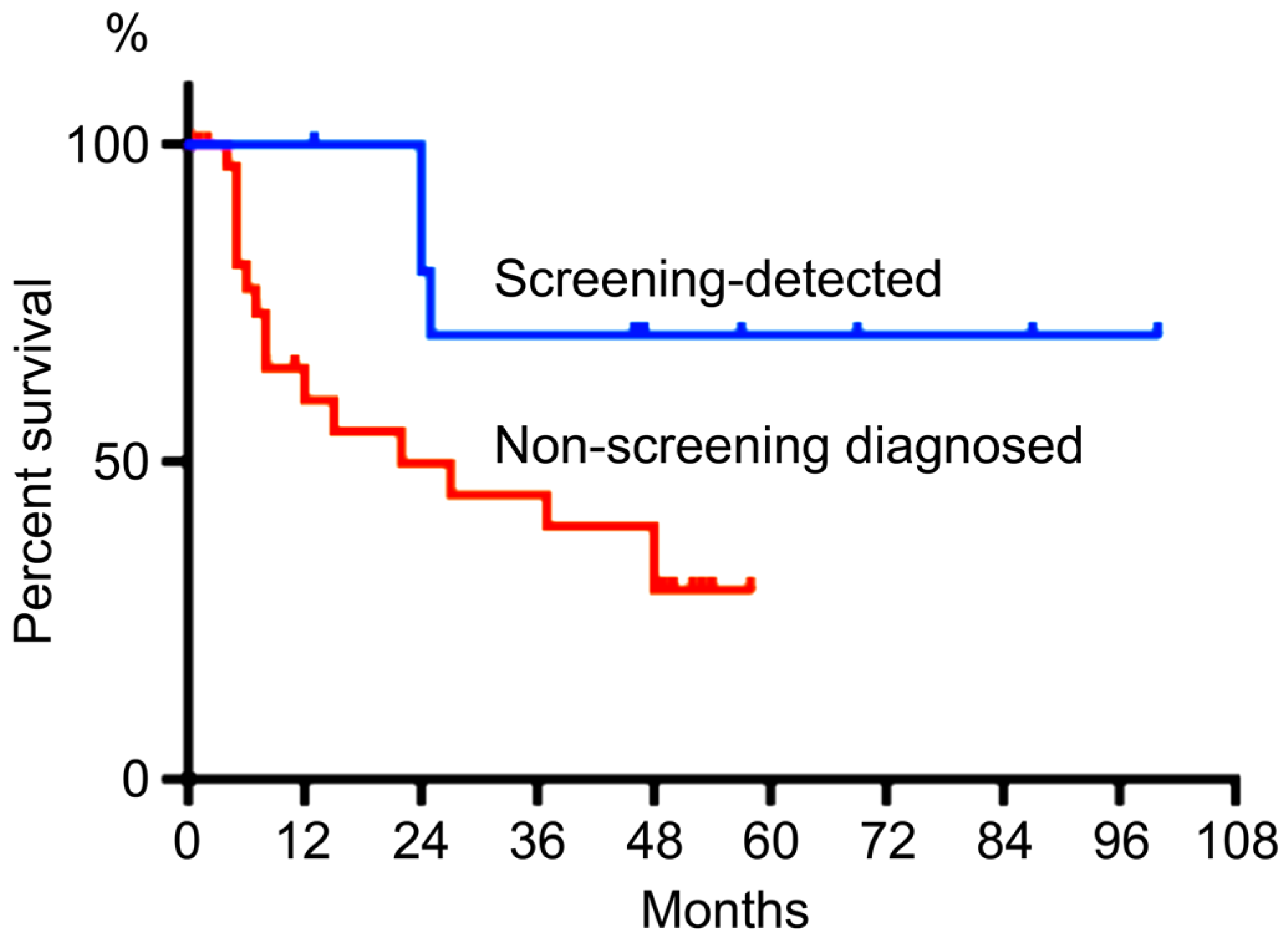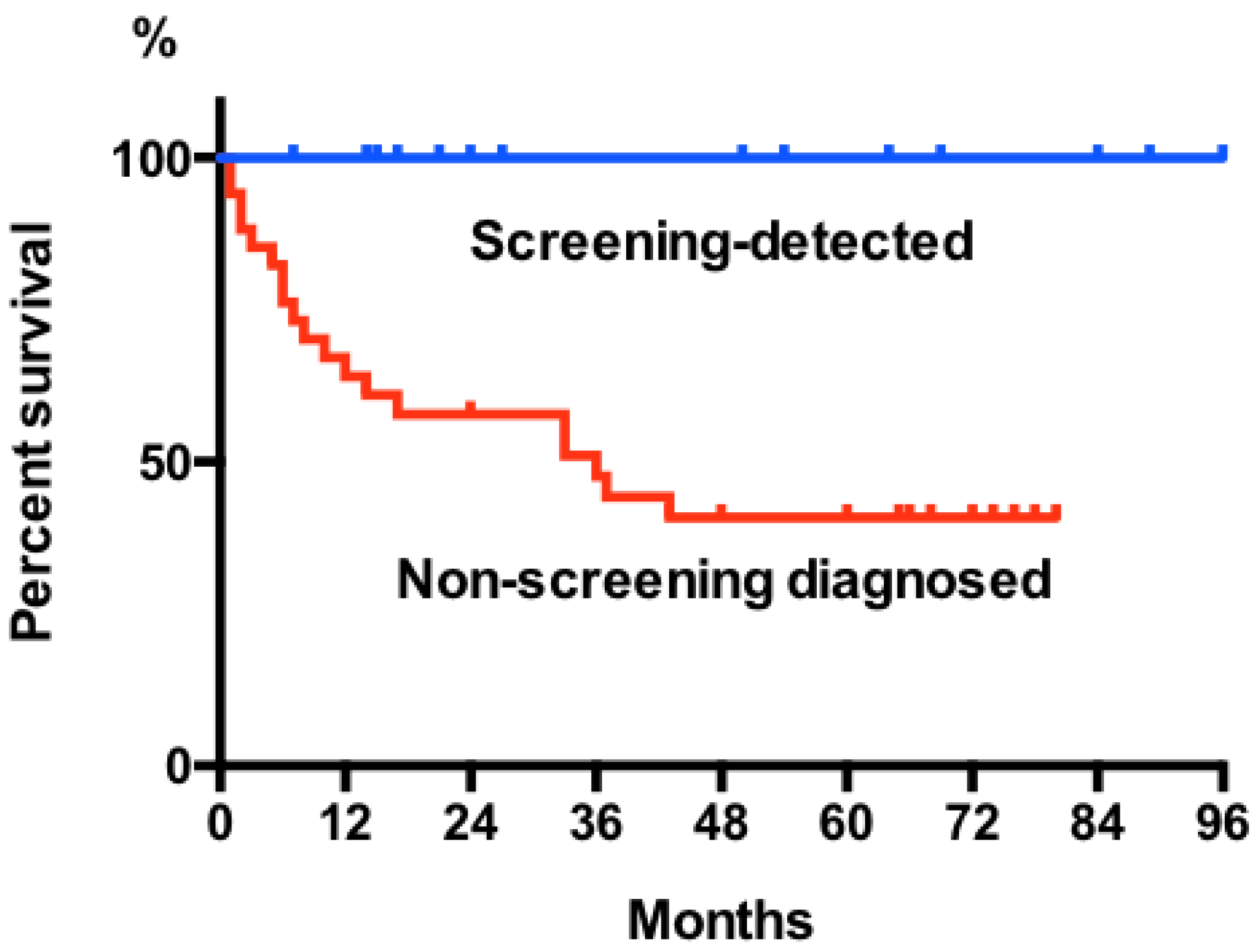The Real-World Outcomes of a Population-Based Gastric Cancer Screening Program for 10 Years in an Urban City near Metropolitan Tokyo: The Usefulness of Early Detection of Gastric and Esophageal Cancer
Abstract
1. Introduction
2. Results
2.1. Baseline Characteristics of the Patients
2.2. Stages, Treatment, and Outcome of Population-Based Screening-Detected GCs
3. Discussion
4. Patients and Methods
4.1. Population-Based GC Screening of Kawasaki City
4.2. Patients
4.3. Helicobacter pylori (Hp) Infection Status
4.4. Statistical Analysis
5. Conclusions
Author Contributions
Funding
Institutional Review Board Statement
Informed Consent Statement
Data Availability Statement
Acknowledgments
Conflicts of Interest
Abbreviations
| GC | gastric cancer |
| EC | esophageal cancer |
| Hp | Helicobacter pylori |
| SCC | squamous cell carcinomas |
| ESD | endoscopic submucosal dissection |
| eCura | endoscopic curability |
| DG | distal gastrectomy |
| TG | total gastrectomy |
| CRT | chemoradiotherapy |
| UGI | upper gastrointestinal |
Appendix A
Appendix A.1. Endoscopic Curability A (eCuraA)
Appendix A.2. Endoscopic Curability B (eCuraB)
Appendix A.3. Endoscopic Curability C (eCuraC)
Appendix B
| Screening-Detected Advanced GC | Non-Screening Diagnosed Advanced GC | ||
|---|---|---|---|
| (n = 11) | (n = 34) | ||
| Age mean (range) | 71.0 (47–86) | 71.2 (42–85) | |
| Sex (male/female) | 8/3 | 24/10 | |
| Stage | I | 3 | 2 |
| II | 6 | 2 | |
| III | 10 | ||
| IV | 2 | 20 | |
| Treatment | Surgery | 11 | 12 |
| Chemotherapy | 16 | ||
| BSC | 6 |
References
- Sung, H.; Ferlay, J.; Siegel, R.L.; Laversanne, M.; Soerjomataram, I.; Jemal, A.; Bray, F. Global cancer statistics 2020: GLOBOCAN estimates of incidence and mortality worldwide for 36 cancers in 185 countries. CA Cancer J. Clin. 2021, 71, 209–249. [Google Scholar] [CrossRef]
- National Cancer Center. Cancer Statistics in Japan. 2023. Available online: https://ganjoho.jp/public/qa_links/report/statistics/2023_en.html (accessed on 26 May 2025).
- Sun, D.; Mülder, D.T.; Li, Y.; Nieboer, D.; Park, J.Y.; Suh, M.; Hamashima, C.; Han, W.; O’Mahony, J.F.; Lansdorp-Vogelaar, I. The effect of nationwide organized cancer screening programs on gastric cancer mortality: A synthetic control study. Gastroenterology 2024, 166, 503–514. [Google Scholar] [CrossRef] [PubMed]
- Fukao, A.; Tsubono, Y.; Tsuji, I.; Hisamichi, S.; Sugahara, N.; Takano, A. The evaluation of screening for gastric cancer in Miyagi Prefecture, Japan: A population-based case-control study. Int. J. Cancer 1995, 60, 45–48. [Google Scholar] [CrossRef] [PubMed]
- Oshima, A. A critical review of cancer screening programs in Japan. Int. J. Technol. Assess. Health Care 1994, 10, 346–358. [Google Scholar] [CrossRef]
- Hamashima, C. Cancer screening guidelines and policy making: 15 years of experience in cancer screening guideline development in Japan. Jpn. J. Clin. Oncol. 2018, 48, 278–286. [Google Scholar] [CrossRef]
- Mabe, K.; Inoue, K.; Kamada, T.; Kato, K.; Kato, M.; Haruma, K. Endoscopic screening for gastric cancer in Japan: Current status and future perspectives. Digest Endosc. 2022, 34, 412–419. [Google Scholar] [CrossRef]
- Kawasaki City Health and Welfare Bureau. Annual Reports of Results of Kawasaki City Gastric and Colon Cancer Screening; Kawasaki City Health and Welfare Bureau: Kawasaki, Japan, 2000. (In Japanese)
- Japanese Society for Gastrointestinal Cancer Screening. Nationwide Survey of Gastric Cancer Screening Status. Available online: https://www.jsgcs.or.jp/files/uploads/2020zenkoku_naisikyo.pdf (accessed on 19 October 2024). (In Japanese).
- Japanese Gastric Cancer Association. Japanese classification of gastric carcinoma: 3rd English edition. Gastric Cancer 2011, 14, 101. [Google Scholar] [CrossRef]
- Japanese Gastric Cancer Association. Japanese Gastric Cancer Treatment Guidelines 2021: 6th edition. Gastric Cancer 2023, 26, 1. [Google Scholar]
- Ministry of Heal, Labor and Welfare. Japanese Life Expectancy at Major Ages Groups. Available online: https://www.mhlw.go.jp/toukei/saikin/hw/life/life23/dl/life23-02.pdf (accessed on 26 May 2025). (In Japanese)
- Huang, R.J.; Epplein, M. An Approach to the primary and secondary prevention of gastric cancer in the United States. Clin. Gast Hepatol. 2021, 20, 2218–2228.e2. [Google Scholar] [CrossRef]
- Chang, E.T.; Clarke, C.A.; Colditz, G.A.; Kurian, A.W.; Hubbell, E. Avoiding lead-time bias by estimating stage-specific proportions of cancer and non-cancer deaths. Cancer Causes Control 2024, 35, 849–864. [Google Scholar] [CrossRef]
- Hamashima, C.; Ogoshi, K.; Okamoto, M.; Shabana, M.; Kishimoto, T.; Fukao, A. A community-based, case-control study evaluating mortality reduction from gastric cancer by endoscopic screening in Japan. PLoS ONE 2013, 8, e79088. [Google Scholar] [CrossRef]
- Hamashima, C.; Shabana, M.; Okada, K.; Okamoto, M.; Osaki, Y. Mortality reduction from gastric cancer by endoscopic and radiographic screening. Cancer Sci. 2015, 106, 1744–1749. [Google Scholar] [CrossRef]
- Kim, Y.; Jun, J.K.; Choi, K.S.; Lee, H.Y.; Park, E.C. Overview of the National Cancer screening programme and the cancer screening status in Korea. Asian Pac. J. Cancer Prev. 2011, 12, 725–730. [Google Scholar]
- Jun, J.K.; Choi, K.S.; Lee, H.Y.; Suh, M.; Park, B.; Song, S.H.; Jung, K.W.; Lee, C.W.; Choi, I.J.; Park, E.C.; et al. Effectiveness of the Korean National Cancer Screening Program in reducing gastric cancer mortality. Gastroenterology 2017, 152, 1319–1328.e7. [Google Scholar] [CrossRef]
- Zhang, X.; Li, M.; Chen, S.; Hu, J.; Guo, Q.; Liu, R.; Zheng, H.; Jin, Z.; Yuan, Y.; Xi, Y.; et al. Endoscopic screening in Asian countries Is associated with reduced gastric cancer mortality: A meta-analysis and systematic review. Gastroenterology 2018, 155, 347–354.e9. [Google Scholar] [CrossRef]
- Uemura, N.; Okamoto, S.; Yamamoto, S.; Matsumura, N.; Yamaguchi, S.; Yamakido, M.; Taniyama, K.; Sasaki, N.; Schlemper, R.J. Helicobacter pylori infection and the development of gastric cancer. N. Engl. J. Med. 2001, 345, 784–789. [Google Scholar] [CrossRef]
- Take, S.; Mizuno, M.; Ishiki, K.; Kusumoto, C.; Imada, T.; Hamada, F.; Yoshida, T.; Yokota, K.; Mitsuhashi, T.; Okada, H. Risk of gastric cancer in the second decade of follow-up after Helicobacter pylori eradication. J. Gastroenterol. 2020, 55, 281–288. [Google Scholar] [CrossRef] [PubMed]
- Graham, D.Y. History of Helicobacter pylori, duodenal ulcer, gastric ulcer and gastric cancer. World J. Gastroenterol. 2014, 20, 5191–5204. [Google Scholar] [CrossRef] [PubMed]
- Nagy, P.; Johansson, S.; Molloy-Bland, M. Systematic review of time trends in the prevalence of Helicobacter pylori infection in China and the USA. Gut Pathog. 2016, 8, 8. [Google Scholar] [CrossRef] [PubMed]
- Hirayama, Y.; Kawai, T.; Otaki, J.; Kawakami, K.; Harada, Y. Prevalence of Helicobacter pylori infection with healthy subjects in Japan. J. Gastroenterol. Hepatol. 2014, 29 (Suppl. S4), 16–19. [Google Scholar] [CrossRef]
- Kamada, T.; Haruma, K.; Ito, M.; Inoue, K.; Manabe, N.; Matsumoto, H.; Kusunoki, H.; Hata, J.; Yoshihara, M.; Sumii, K.; et al. Time trends in Helicobacter pylori infection and atrophic gastritis over 40 years in Japan. Helicobacter 2015, 20, 192–198. [Google Scholar] [CrossRef]
- Yanaoka, K.; Oka, M.; Mukoubayashi, C.; Yoshimura, N.; Enomoto, S.; Iguchi, M.; Magari, H.; Utsunomiya, H.; Tamai, H.; Arii, K.; et al. Cancer high-risk subjects identified by serum pepsinogen tests: Outcomes after 10-year follow-up in asymptomatic middle-aged males. Cancer Epidemiol. Biomarkers Prev. 2008, 17, 838–845. [Google Scholar] [CrossRef]
- Terasawa, T.; Nishida, H.; Kato, K.; Miyashiro, I.; Yoshikawa, T.; Takaku, R.; Hamashima, C. Prediction of gastric cancer development by serum pepsinogen test and Helicobacter pylori seropositivity in Eastern Asians: A systematic review and meta-analysis. PLoS ONE 2014, 9, e109783. [Google Scholar] [CrossRef]
- Hamashima, C. Systematic Review Group and Guideline Development Group for Gastric Cancer Screening Guidelines. Update version of the Japanese Guidelines for Gastric Cancer Screening. Jpn. J. Clin. Oncol. 2018, 48, 673–683. [Google Scholar] [CrossRef] [PubMed]
- Chei, C.L.; Nakamura, S.; Watanabe, K.; Watanabe, R.; Kurokawa, A.; Iweane, T.; Itoh, S.; Narimatsu, H. Projection of future gastric cancer incidence and health-care service demand by geographic area in Kanagawa, Japan. Cancer Sci. 2025, 116, 488–499. [Google Scholar] [CrossRef] [PubMed]
- Domper Arnal, M.J.; Ferrández Arenas, Á.; Lanas Arbeloa, Á. Esophageal cancer: Risk factors, screening and endoscopic treatment in Western and Eastern countries. World J. Gastroenterol. 2015, 21, 7933–7943. [Google Scholar] [CrossRef] [PubMed]
- Kim, J.H.; Han, K.D.; Lee, J.K.; Kim, H.S.; Cha, J.M.; Park, S.; Kim, J.S.; Kim, W.H.; Big Data Research Group (BDRG) of the Korean Society of Gastroenterology (KSG). Association between the National Cancer Screening Programme (NSCP) for gastric cancer and oesophageal cancer mortality. Br. J. Cancer 2020, 123, 480–486. [Google Scholar] [CrossRef]
- Goto, E.; Ishikawa, H.; Okuhara, T.; Kiuchi, T. Relationship of health literacy with utilization of health-care services in a general Japanese population. Prev. Med. Rep. 2019, 14, 100811. [Google Scholar] [CrossRef]
- Japan Esophageal Society. Esophageal cancer practice guidelines 2022. Esophagus 2023, 20, 343–389. [Google Scholar] [CrossRef]
- Suzuki, H.; Sano, M.; Nishizawa, T.; Toyoshima, O. Endoscopic diagnosis of early gastric cancer and high-risk gastritis. Korean J. Helicobacter Up. Gastrointest. Res. 2024, 24, 311–318. [Google Scholar] [CrossRef]








| Stage Grouping | n | Treatment | n | |
|---|---|---|---|---|
| Gastric cancer | Stage IA | 69 | ESD | 63 |
| DG | 6 | |||
| Stage IB | 25 | DG/TG | 13 | |
| ESD | 6 | |||
| ESD→DG | 6 | |||
| Stage IIA | 6 | DG/TG | 6 | |
| Stage IVB | 2 | DG/TG | 2 | |
| Esophageal cancer | Stage 0 (T1a) | 11 | ESD | 9 |
| Thoracic esophagectomy | 1 | |||
| CRT | 1 | |||
| Stage I (T1b) | 4 | ESD | 1 | |
| CRT | 3 | |||
| Stage II | 2 | Thoracic esophagectomy | 2 | |
| Stage III | 1 | CRT | 1 |
Disclaimer/Publisher’s Note: The statements, opinions and data contained in all publications are solely those of the individual author(s) and contributor(s) and not of MDPI and/or the editor(s). MDPI and/or the editor(s) disclaim responsibility for any injury to people or property resulting from any ideas, methods, instructions or products referred to in the content. |
© 2025 by the authors. Licensee MDPI, Basel, Switzerland. This article is an open access article distributed under the terms and conditions of the Creative Commons Attribution (CC BY) license (https://creativecommons.org/licenses/by/4.0/).
Share and Cite
Yasuda, H.; Maehata, T.; Sato, Y.; Kiyokawa, H.; Kato, M.; Nakamoto, Y.; Komatsu, T.; Tateishi, K. The Real-World Outcomes of a Population-Based Gastric Cancer Screening Program for 10 Years in an Urban City near Metropolitan Tokyo: The Usefulness of Early Detection of Gastric and Esophageal Cancer. Gastrointest. Disord. 2025, 7, 49. https://doi.org/10.3390/gidisord7030049
Yasuda H, Maehata T, Sato Y, Kiyokawa H, Kato M, Nakamoto Y, Komatsu T, Tateishi K. The Real-World Outcomes of a Population-Based Gastric Cancer Screening Program for 10 Years in an Urban City near Metropolitan Tokyo: The Usefulness of Early Detection of Gastric and Esophageal Cancer. Gastrointestinal Disorders. 2025; 7(3):49. https://doi.org/10.3390/gidisord7030049
Chicago/Turabian StyleYasuda, Hiroshi, Tadateru Maehata, Yoshinori Sato, Hirofumi Kiyokawa, Masaki Kato, Yusuke Nakamoto, Takumi Komatsu, and Keisuke Tateishi. 2025. "The Real-World Outcomes of a Population-Based Gastric Cancer Screening Program for 10 Years in an Urban City near Metropolitan Tokyo: The Usefulness of Early Detection of Gastric and Esophageal Cancer" Gastrointestinal Disorders 7, no. 3: 49. https://doi.org/10.3390/gidisord7030049
APA StyleYasuda, H., Maehata, T., Sato, Y., Kiyokawa, H., Kato, M., Nakamoto, Y., Komatsu, T., & Tateishi, K. (2025). The Real-World Outcomes of a Population-Based Gastric Cancer Screening Program for 10 Years in an Urban City near Metropolitan Tokyo: The Usefulness of Early Detection of Gastric and Esophageal Cancer. Gastrointestinal Disorders, 7(3), 49. https://doi.org/10.3390/gidisord7030049






